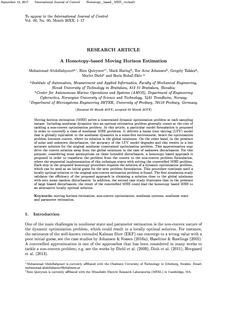| dc.contributor.author | Abdollahpouri, Mohammad | |
| dc.contributor.author | Quirynen, Rien | |
| dc.contributor.author | Haring, Mark | |
| dc.contributor.author | Johansen, Tor Arne | |
| dc.contributor.author | Takács, Gergely | |
| dc.contributor.author | Diehl, Moritz | |
| dc.contributor.author | Rohal'-Ilkiv, Boris | |
| dc.date.accessioned | 2017-12-18T07:52:44Z | |
| dc.date.available | 2017-12-18T07:52:44Z | |
| dc.date.created | 2017-12-11T12:20:17Z | |
| dc.date.issued | 2017 | |
| dc.identifier.issn | 0020-7179 | |
| dc.identifier.uri | http://hdl.handle.net/11250/2472271 | |
| dc.description.abstract | Moving horizon estimation (MHE) solves a constrained dynamic optimisation problem. Including nonlinear dynamics into an optimal estimation problem generally comes at the cost of tackling a non-convex optimisation problem. Here, a particular model formulation is proposed in order to convexify a class of nonlinear MHE problems. It delivers a linear time-varying (LTV) model that is globally equivalent to the nonlinear dynamics in a noise-free environment, hence the optimisation problem becomes convex. On the other hand, in the presence of unknown disturbances, the accuracy of the LTV model degrades and this results in a less accurate solution. For this purpose, some assumptions are imposed and a homotopy-based approach is proposed in order to transform the problem from convex to non-convex, where the sequential implementation of this technique starts with solving the convexified MHE problem. Two simulation studies validate the efficiency and optimality of the proposed approach with unknown disturbances. | nb_NO |
| dc.language.iso | eng | nb_NO |
| dc.publisher | Taylor & Francis | nb_NO |
| dc.relation.uri | https://doi.org/10.1080/00207179.2017.1406150 | |
| dc.title | A homotopy-based moving horizon estimation | nb_NO |
| dc.type | Journal article | nb_NO |
| dc.type | Peer reviewed | nb_NO |
| dc.description.version | acceptedVersion | nb_NO |
| dc.source.journal | International Journal of Control | nb_NO |
| dc.identifier.doi | 10.1080/00207179.2017.1406150 | |
| dc.identifier.cristin | 1525599 | |
| dc.relation.project | Det europeiske økonomiske samarbeidsområde (EØS): SK06-II- 01-004 | nb_NO |
| dc.relation.project | EC/FP7/607957 | nb_NO |
| dc.relation.project | EU/259166 | nb_NO |
| dc.relation.project | Norges forskningsråd: 250275 | nb_NO |
| dc.relation.project | Norges forskningsråd: 223254 | nb_NO |
| dc.relation.project | EU/642682 | nb_NO |
| dc.description.localcode | This is an Accepted Manuscript of an article published by Taylor & Francis in International Journal of Control on 08 Dec 2017, available online:http://www.tandfonline.com/doi/full/10.1080/00207179.2017.1406150 . Locked until 08 December 2018 due to copyright restrictions | nb_NO |
| cristin.unitcode | 194,63,25,0 | |
| cristin.unitname | Institutt for teknisk kybernetikk | |
| cristin.ispublished | true | |
| cristin.fulltext | postprint | |
| cristin.qualitycode | 1 | |
